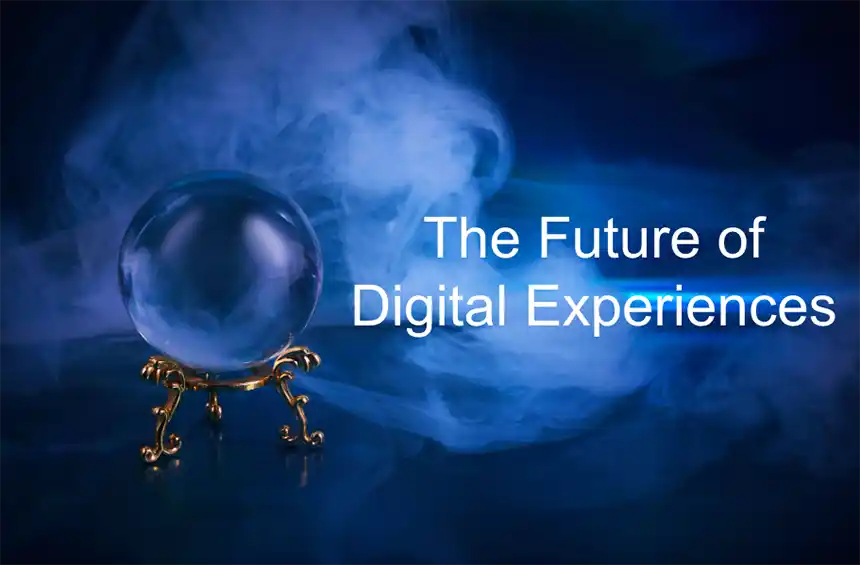Navigating the Future of Digital Experiences: A Deep Dive into Emerging Trends

Amanda Jones

In the realm of digital content and experiences, the pace of innovation continues to accelerate, driven by advancements in technology and shifts in consumer expectations. The keynote speech at CrafterCMS Live! 2024 outlined the primary trends that are shaping the future of digital experiences, emphasizing the central role of advanced content management systems like CrafterCMS. Content-centric digital experiences include personalized enterprise websites, mobile apps, OTT video experiences, AR/VR and IoT devices, e-commerce, digital signage, and the like. This blog post summarizes six key trends, exploring how they influence all the various aspects and types of digital experiences, and what they mean for enterprises looking to stay ahead in a digital-first world.
Trend 1. Generative AI: Transforming Content Creation
The emergence of generative AI, particularly through Large Language Models (LLMs) such as ChatGPT, is revolutionizing the content creation landscape. These AI tools are capable of generating both textual and visual content, enhancing productivity and efficiency across numerous domains.
Applications in Content Marketing
Generative AI is proving to be a game-changer for content marketers, editors, and publishers by automating the creation of articles, product descriptions, and blog posts. This technology not only drafts content based on brief outlines but also enhances it by generating SEO-friendly metadata and titles, significantly reducing the workload on human creators.
Personalization at Scale
Beyond content creation, AI is instrumental in personalizing user experiences. By analyzing user behavior and demographics, AI can tailor website content, email campaigns, and advertisements to increase engagement rates and conversions. However, while AI excels at scaling content personalization, it requires careful supervision to manage issues related to content accuracy and sensitivity, avoiding the pitfalls of producing irrelevant or even misleading information.
Search Generated Experiences
The emergence of AI-enabled search, for example Google and its Search Generated Experiences (SGE), marks a significant shift in how we will think about search engine optimization. SGE leverages AI to create dynamic, personalized content experiences directly from search queries. As AI-enabled SEO technologies like SGE become more prevalent, they will require new thinking about content management, beyond traditional keywords, metadata, titles, URLs, and such. They call for a strategic approach to content management that is more AI-compatible. This includes structuring content in ways that are easily consumed by machines and AI, using schemas and markup that enhance machine understanding, and adopting content strategies that anticipate and adapt to the shifting algorithms of search engines.
Read More: Structured Content in a Headless CMS
Trend 2. Expanding Digital Channels
As technology evolves, so too does the landscape of digital channels through which businesses can engage with customers. This trend is highlighted by the proliferation of digital touchpoints, from traditional web and mobile experiences to innovative applications like augmented reality (AR) and voice assistants.
Augmented Reality
AR is becoming a vital tool in industries such as retail, education, and manufacturing. Apple's Vision Pro is just the latest in new devices that are making AR a reality for many applications. For instance, in retail, AR allows customers to visualize products in a real-world context before purchase, significantly enhancing the shopping experience. In education, AR can provide immersive learning experiences that adapt to different learning styles and needs.
Voice Assistants and AI Chatbots
Devices powered by AI, like Alexa or Google Home, along with AI chatbots, are redefining customer service. These tools can handle vast volumes of interactions simultaneously, providing personalized responses and maintaining a high level of customer satisfaction. The integration of these technologies into customer service strategies offers a glimpse into the future of automated yet personalized customer engagement.
An example here is Klarna, a Swedish fintech company, who reported amazing success with its AI assistant, powered by OpenAI. Since its global launch after just one month, the AI assistant handled almost 2 and half million conversations. And the AI assistant has achieved a customer satisfaction score on par with human agents.
Trend 3. Frontier Technologies in Frontend Development
The development of digital experiences is also being shaped by new technologies that allow for more dynamic, responsive, and efficient web applications. Frameworks such as React, Vue, Angular, and server-side technologies like Next.js are enhancing the capabilities of developers to create fast-loading and SEO-friendly websites.
Emerging Technologies
Technologies like Apple’s ARKit and the JavaScript library HTMX are pushing the boundaries further, enabling developers to create applications that are deeply integrated with the user's physical environment or to enhance sites with dynamic content without heavy reliance on traditional JavaScript frameworks.
Headless CMS Development
When it comes to leveraging these new technologies to build new content-centric digital experiences, an enterprise-grade headless CMS like CrafterCMS provides the content foundation. On the frontend developers can choose whichever development technology to build with, whether it's HTML5 and Bootstrap, or React and Nextjs, or dedicated mobile app frameworks, or Vision Pro apps, or anything else. With Crafter Engine, you get a headless content delivery platform with comprehensive API support - including REST and GraphQL APIs for headless development.
In addition, CrafterCMS also embeds Apache Freemarker for templated site development, provides comprehensive search APIs backed by OpenSearch, and enables server-side scripting with Groovy for back end customization, API development and third-party system integrations. Both client-side and server-side rendering is fully supported as well. For example, server-side rendering with frameworks like Nodejs and Nextjs is important for performance, SEO and more.
User-friendly Content Authoring
With Crafter Studio and its new Experience Builder, content authoring teams get a user-friendly, visual editing experience that works across all these technologies and digital channels. No matter which technologies the developers use for frontend development, content authors get the same visual experience.
Trend 4. The Rise of Composable Architectures
Composable architectures represent a paradigm shift in digital experience delivery, focusing on flexibility, speed, and modularity. This approach allows businesses to quickly adapt and reassemble digital components to respond to user feedback or market changes without being hindered by monolithic system architectures.
Modularity and Agility
With composable architectures, companies can develop digital experiences that are more aligned with current user expectations. CrafterCMS supports this through a rich marketplace of plugins and integrations that enable rapid assembly and reassembly of digital components, embodying the principles of agility and modularity.
Composable Authoring and End User Experiences
From a content management perspective, composable CMS architectures must apply to both the content authoring experience, as well as the end user experience.
A composable content authoring experience drives productivity as the tools and workflows can be tailored for each site or app that is being managed, and can be specialized to each different user’s role - whether a content creator, editor, reviewer, approver, and such.
Similarly, a composable end user experience, for your site and app visitors, means that developers and content creators can more quickly build, deploy, and optimize the site or app experience with prebuilt components and integrations.
Trend 5. DevContentOps: Integrating Content and Operations
Borrowing from the principles of DevOps, DevContentOps is an approach that integrates content management with IT operations to streamline the development, management, and delivery of digital experiences. This methodology emphasizes collaboration, automation, continuous integration, and delivery, aiming to reduce silos between content creators and IT teams.
Benefits of DevContentOps
By fostering a more collaborative environment, DevContentOps helps organizations publish content updates faster, release new features more efficiently, and enhance the overall performance of digital experiences. This integrated approach is crucial for maintaining a competitive edge in a fast-paced digital market.
DevContentOps extends the DevOps lifecycle to include processes for easily moving code forward content back among environments – all of which saves time, eliminates busy work and reduces error. Just as DevOps brought developers and IT operations together, DevContentOps fosters collaboration between content creators, web developers, security teams, and IT operations.
Git-based Content Management
All of this can be realized with CrafterCMS which utilizes Git as its underlying content repository. With all content, code and configuration living in the same distributed repository, all these teams can work more effectively: publishing new content updates faster, releasing new software features quicker, and delivering higher-performing customer experiences. The trends we’ve been talking about: generative AI, new digital channels and technologies, composable architectures – all drive the need for higher productivity through DevContentOps.
Trend 6. Elevated Cybersecurity Measures
As digital experiences become more complex and pervasive, the importance of robust cybersecurity measures grows. The increasing sophistication of cyber threats requires comprehensive security strategies to protect digital assets and user data.
Secure CMS Architecture
CrafterCMS has implemented a secure architecture that includes secure APIs and a decoupled content delivery system. This structure ensures that vulnerabilities in the delivery system do not impact internal systems. Moreover, CrafterCMS adheres to stringent security processes, including regular code reviews and the integration of security practices throughout the development process.
Secure Processes
Another key to CrafterCMS's approach to security are also clearly-defined policies that establish a strong foundation for all our security practices. Policies include adherence to industry standards (e.g., SOC2), responsible disclosure practices, and serving as the CVE numbering authority for the open source CrafterCMS project - working closely with the CVE Program that governs the process for identifying and cataloging all vulnerabilities.
Our processes include both manual and automated code reviews, secure code development processes, and the benefits of our open source releases and open source community, which include independent security researchers and bug bounty hunters who we compensate for finding security issues.
Another key component of our security strategy is maintaining a clean supply chain of dependencies. Daily dependency scans, publishing our full Software Bill of Materials (SBOM) and identifying vulnerabilities through the Vulnerability Exploitability Exchange (or VEX), enables us to respond swiftly to potential threats.
Our commitment to security is further demonstrated through our testing regimen. We conduct continuous testing, covering all areas including functionality, penetration testing of our APIs and User Interface, and load testing of both the Content Authoring and Content Delivery systems.
Conclusion: Embracing the Digital Future
These trends underscore the dynamic nature of digital experience development and the critical role of content management systems in navigating this landscape. As enterprises look to leverage these trends, they must focus on integrating advanced technologies like AI, enhancing digital channels, and adopting flexible architectures while ensuring robust security measures are in place.
CrafterCMS is well-positioned at the intersection of these trends, offering tools and capabilities that help businesses adapt to and thrive in the evolving digital ecosystem. As we move forward, the integration of these advanced technologies and strategies will be paramount for businesses aiming to provide exceptional digital experiences that meet the needs of modern consumers.
By staying informed and proactive, enterprises can harness these insights to not only keep pace with technological advancements but to drive innovation and growth in their digital strategies. The future of digital experiences is bright, and it beckons with opportunities for those ready to embrace its challenges and potentials.
Learn more by watching the CrafterCMS Live! 2024 Keynote Address, The Future of Digital Experiences.
Related Posts

Building Custom Plugins for a Composable CMS

Amanda Lee

Building Personalized Digital Experiences for a Cruise Liner

Sara Williams

CrafterCMS Wins More G2 Awards Spring 2024

Amanda Lee

What Is a Cloud CMS? (Unlocking the Benefits of a CMS in the Cloud)

Sara Williams
Related Resources
-

Personalized Digital Experiences for a Cruise Liner
Webcast
-

Introducing CrafterCMS v4.0
Webcast
-

Modernizing Video Delivery and Content Management at CPAC, A Canadian Nationwide Broadcaster
Webcast
-

AI-based Media Asset Management with AWS Rekognition and CrafterCMS
Webcast
-

Building React Apps on a Headless CMS
White Paper





